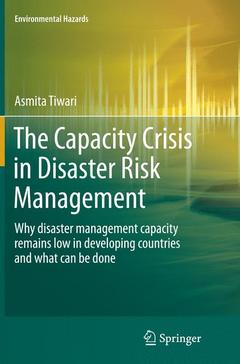Description
The Capacity Crisis in Disaster Risk Management, Softcover reprint of the original 1st ed. 2015
Why disaster management capacity remains low in developing countries and what can be done
Environmental Hazards Series
Author: Tiwari Asmita
Language: English
Subjects for The Capacity Crisis in Disaster Risk Management:
Publication date: 10-2016
Support: Print on demand
Publication date: 03-2015
218 p. · 15.5x23.5 cm · Hardback
Description
/li>Contents
/li>Biography
/li>Comment
/li>
How can a place be built and managed so that it is safe for people to live? Ironically, many governments and citizens keep on asking the same question after every new disaster. Why, even with high levels of investment in increasing government?s capacity to manage disasters, do the impacts of disasters continue to increase? What can the governments do differently? What is the role of local communities? Where should aid agencies invest? This book looks into these critical questions and highlights how current capacity development efforts might be resulting in the opposite?capacity crisis or capability trap. The book provides a new approach for the understanding and the developing of effective local capacity to reduce and manage future disaster impacts.
These books may interest you

Local Disaster Management 105.47 €



